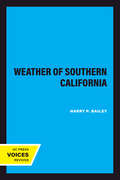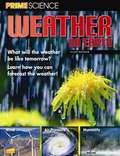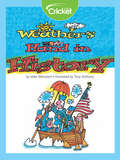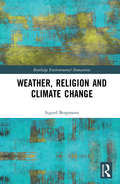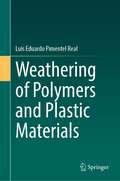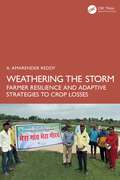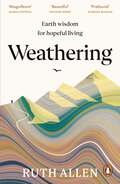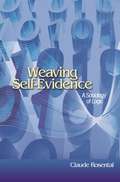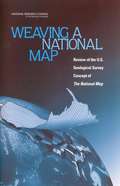- Table View
- List View
Weather and Climate Patterns
by Janette SchusterWeather Patterns, The Water Cycle, Climate Patterns, Science and Engineering Practices, Careers.
Weather and Climate Science
by Glencoe Mcgraw-HillThis series brings together both the underpinning principles and new developments in meteorology for students, as well as being a useful resource for the professional meteorologist or Earth system scientist.
Weather and Climate Systems Student Guide and Source Book (STC Science and Technology Concepts Middle School)
by Smithsonian Science Education Center StaffGrades 6–8. This Student Guide and Source Book provides the student investigations, student goals and objectives, and reading selections for the Weather and Climate Systems unit.
Weather and Climate: Establishing an Orangutan Reserve
by The Lawrence Hall of ScienceNIMAC-sourced textbook
Weather and Climate: Establishing an Orangutan Reserve, Investigation Notebook (Amplify Science)
by The Lawrence Hall of ScienceNIMAC-sourced textbook
Weather and Water
by Lawrence Hall of Science University of California at BerkeleyNIMAC-sourced textbook
Weather and Water
by Lawrence Hall of Science University of California at BerkeleyNIMAC-sourced textbook
Weather and Water Resources
by University of California at Berkeley Lawrence Hall of ScienceNIMAC-sourced textbook
Weather and Water Resources: Images, Data and Readings
by Associates FOSS Middle School Project StaffThe book presents the weather and water resources around the world with images and related data and readings.
Weather and the Sun (Inspire Science, Grade K #Unit 3)
by McGraw-Hill EducationNIMAC-sourced textbook
Weather of Southern California (California Natural History Guides #17)
by Harry P. BaileyThis title is part of UC Press's Voices Revived program, which commemorates University of California Press’s mission to seek out and cultivate the brightest minds and give them voice, reach, and impact. Drawing on a backlist dating to 1893, Voices Revived makes high-quality, peer-reviewed scholarship accessible once again using print-on-demand technology. This title was originally published in 1966.
Weather on Earth
by Brett Kelly Hilary MaybaumFrom temperature to humidity to winds, this book tells you what you need to know about weather. You'll find out what causes weather, how and why it changes, and on what weather predictions are based. Learn how to interpret weather data and make your own weather forecasts! (Set of 10)
Weather on Earth
by Lawrence Hall of Science University of California at BerkeleyNIMAC-sourced textbook
Weather's Hand in History
by Mike WeinsteinWeather affects us almost every day. When it's raining, we can't play outside. Sometimes weather is even more important. Sometimes weather shapes history.
Weather, Religion and Climate Change (Routledge Environmental Humanities)
by Sigurd BergmannWeather, Religion and Climate Change is the first in-depth exploration of the fascinating way in which the weather impacts on the fields of religion, art, culture, history, science, and architecture. In critical dialogue with meteorology and climate science, this book takes the reader beyond the limits of contemporary thinking about the Anthropocene and explores whether a deeper awareness of weather might impact on the relationship between nature and self. Drawing on a wide range of examples, including paintings by J.M.W. Turner, medieval sacred architecture, and Aristotle’s classical Meteorologica, Bergmann examines a geographically and historically wide range of cultural practices, religious practices, and worldviews in which weather appears as a central, sacred force of life. He also examines the history of scientific meteorology and its ambivalent commodification today, as well as medieval "weather witchery" and biblical perceptions of weather as a kind of "barometer" of God’s love. Overall, this volume explores the notion that a new awareness of weather and its atmospheres can serve as a deep cultural and spiritual driving force that can overcome the limits of the Anthropocene and open a new path to the "Ecocene", the age of nature. Drawing on methodologies from religious studies, cultural studies, art history and architecture, philosophy, environmental ethics and aesthetics, history, and theology, this book will be of great interest to all those concerned with studying the environment from a transdisciplinary perspective on weather and wisdom.
Weathering of Polymers and Plastic Materials
by Luís Eduardo RealThis book presents the state of the art on the weathering of polymers and plastic materials in outdoor applications, comprising natural weathering, accelerated climatic weathering, laboratory artificial accelerated weathering, and lifetime prediction methodology. It summarizes the most suitable methods of instrumental analysis to access and quantify (when possible) degradation caused by weathering, while also covering the degradation and stabilization of polymers based on environmental and artificially induced factors. Innovative polymer additives and some developments in polymeric materials designed for outdoor applications are also included, emphasizing a few selected cases. the book intends to be an important reference source for those involved in the study of the durability of polymers and plastics, production of plastics for exterior applications, chemists responsible for quality control of plastic products, and researchers and students across plastics engineering, polymer science, polymer chemistry and environmental science.
Weathering the Storm: Farmer Resilience and Adaptive Strategies to Crop Losses
by A. Amarender ReddySmallholder farmers face relentless challenges from pests, diseases, and the severe impacts of climate change across developing countries. Each year, they endure droughts and floods, thrusting them into a vicious cycle of poverty and distress. Weathering the Storm: Farmer Resilience and Strategies for Crop Losses provides a vital exploration of these issues, offering insights into the struggles and resilience of farmers in the wake of devastating crop losses.Drawing on data from 1,440 farmers who faced severe crop losses in three states namely Telangana, Andhra Pradesh, and Karnataka of India, the book uncovers: Staggering Losses: Crop losses range from 30% to 100%, causing financial damages of three to five lakhs rupees per farmer Government Response: A critical analysis of various assistance programs, highlighting the effectiveness of schemes like the Pradhan Mantri Fasal Bima Yojana (PMFBY) and YSR free crop insurance Resilience Strategies: Insights into the self-adopted strategies farmers use to cope with challenges, alongside governmental support Effective Governance: Examines Andhra Pradesh’s decentralized governance model as a best practice for rapid response Farmers Distress Index (FDI): Introduction of an innovative forewarning system to identify farmers and areas in urgent need of intervention
Weathering: How the earth's deep wisdom can help us endure life's storms
by Ruth AllenRocks and mountains have withstood aeons of life on our planet - gradually eroding, shifting, solidifying, and weathering. We might spend a little less time on earth, but humans are also weathering: evolving and changing as we're transformed by the shifting climates of our lives and experiences. So, what might these ancient natural forms have to teach us about resilience and change?In a stunning exploration of our own connection to these enduring forms, outdoor psychotherapist and geologist Ruth Allen takes us on a journey through deep time and ancient landscapes, showing how geology - which has formed the bedrock of her own adult life and approach to therapy - can offer us a new way of thinking about our own grief, change and boundaries.In a world shaken by physical, political, and medical disasters, Weathering argues for a deeper understanding of the ground beneath our feet to better serve ourselves and the world we live in.
Weaving Self-Evidence: A Sociology of Logic (Princeton Studies in Cultural Sociology #13)
by Claude RosentalThe development of theorems in logic is generally thought to be a solitary and purely cerebral activity, and therefore unobservable by sociologists. In Weaving Self-Evidence, French sociologist Claude Rosental challenges this notion by tracing the history of one well-known recent example in the field of artificial intelligence--a theorem on the foundations of fuzzy logic. Rosental's analyses disclose the inherently social nature of the process by which propositions in logic are produced, disseminated, and established as truths. Rosental describes the different phases of the emergence of the theorem on fuzzy logic, from its earliest drafts through its publication and diffusion, discussion and reformulation, and eventual acceptance by the scientific community. Through observations made at major universities and scholarly conferences, and in electronic forums, he looks at the ways students are trained in symbolic manipulations and formal languages and examines how researchers work, interact, and debate emerging new ideas. By carefully analyzing the concrete mechanisms that lead to the collective development and corroboration of proofs, Rosental shows how a logical discovery and its recognition within the scholarly community are by no means the product of any one individual working in isolation, but rather a social process that can be observed and studied. Weaving Self-Evidence will interest students and researchers in sociology and the history and philosophy of science and technology, and anyone curious about how scientists work.
Weaving a National Map: Review of the U.S. Geological Survey Concept of The National Map
by Committee to Review the U.S. Geological Survey Concept of The National MapWeaving a National Map draws on contributions to a September 2002 workshop and the U.S. Geological Survey's (USGS) "vision" document for The National Map, envisioned by the USGS as a database providing public domain core geographic data about the United States and its territories that other agencies can extend, enhance, and reference as they concentrate on maintaining other data that are unique to their needs. The demand for up-to-date information in real time for public welfare and safety informs this need to update an aging paper map series that is, on average, 23 years old. The NRC report describes how "The National Map initiative would gain from improved definition so that the unprecedented number of partners needed for success will become energized to participate. The challenges faced by USGS in implementing "The National Map are more organizational than technical. To succeed, the USGS will need to continue to learn from challenges encountered in its ongoing pilot studies as well as from other federal-led programs that have partnered with multiple sectors.

